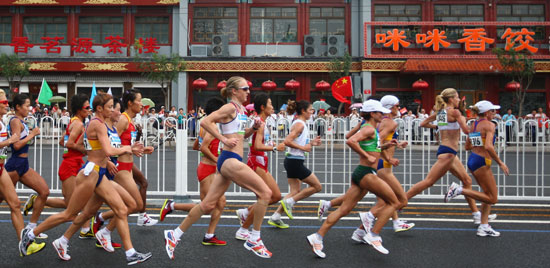by Steven Sashen. Let us guess, you ditched the cushioned clodhoppers only to find a new host of issues to deal with. Blisters on the bottom of your feet? Sore hips? Calves aching so much you can’t walk? Soak in some Epsom Salt and give yourself a break. No one said changing a lifetime of running habits overnight would be easy. No matter what shoe (or lack thereof) you wear, if you don’t change your stride, it won’t matter. Not sure if you’re “doing it right?” Below are five common missteps to set your stride straight.
Misstep #1 Incorrect Stride Rate
When it comes to running, we get into a groove and find a familiar, comfortable place. We expect things to feel a certain way. With a forefoot or mid-foot stride, your cadence or stride rate naturally picks up, so you shorten your steps to roughly 180 steps per minute. Initially, it will feel very strange and awkward, and you may need to do some game time internal persuasion to stay consistent. Stick with it and you will be surprised how quickly you become accustomed to your new stride (and the pain-free knees that accompany). Remember, forefoot/mid-foot striding in a minimalist shoe requires stronger calves, Achilles, tendons, ligaments and bones – you will slow down initially, but as you strengthen so does your speed. Take your time and slowly work your mileage up.
Misstep # 2 Over-striding
Over-striding jars the body and puts unnecessary strain on your ankles, knees and back. Watch your feet closely as you run. Do your feet land under your center of mass where they should or in front of your body? The closer they are to you, the better. It is also common for runners to kick their legs out in front, then land lightly on the forefoot, rather than keeping a normal stride. Think of it as a modest can can dance in running form. Why add the extra stride and expend extra energy without the payoff? Keep your stride short and land under your center of mass.
Misstep #3 Pushing/Pulling Your Stride
Are you taking off for a run only to find a nasty blister swelling on the ball of your foot afterwards? When you push off for your stride, or pull your foot back towards your body to complete your stride, you’re smearing your foot across the ground. All of that extra friction is sure to create an uncomfortable blister or two. Keep your stride light and eliminate the foot smear and you will quickly find your blisters long gone.
Misstep #4 Incorrect Placing and Lifting of the Feet
Are you jamming your foot to the ground and using a heavy stride? Going lighter and minimalist not only includes your shoe but your stride as well. When you run, imagine you are sneaking up on an elk in the woods or running on hot coals. Place your forefoot or mid-foot on the ground, then quickly lift it back up. The faster you move, the better. Doing this will keep your stride light, fast, and put less strain on your body.
Misstep #5 Asymmetry
Have you experienced a blister or soreness on one foot, but not the other? Pain in only one shoulder? Stronger strain in the right Achilles but not the left? Your symmetry is off. This is easy to do but also easy to fix. If you consciously try to have your feet, legs and arms move symmetrically in the same way, you will find most of your problems cease immediately. This becomes more crucial at the end of the run when you are fatigued and your stride isn’t as precise, your arms aren’t as stiff. Strive to keep yourself strong and symmetrical to the last step.
Of course, there is the granddaddy of all missteps – the heel strike. We hope that no one is shedding their shoes only to pound their heels into the pavement (ouch!) Be sure to take on a forefoot or mid-foot stride and let your heel gently touch the ground as you roll through your step.
Have you done any of these? We know we have! If you’ve overcome any stride challenges, do share. Your experiences may help someone else out there.
This essay originally appeared on the site for Invisible Shoes, where Steven Sashen is CEO.


Excellent article. I have had problems with symmetry and didn’t notice why I was getting this wierd knee pain until I recorded myself running and instantly noticed one are acting as it should and the other swinging accross my body. As soon as I fixed the arm movement the knee pain disappeared. Everything is connected. No I always try to run in the moment and think consiously about what every part of my body is doing. Posture- check, Arms- check, etc. etc.
Sorry for the spelling- horrible.
Its such a work in progress! It was enlightening To read about asymmetry. I get shoulder pain only on my left side and it feels like a rotator issue from my arm swing. Interesting that it’s not just me 🙂
Great article, thanks for helping beginners like myself! I’m following all 5 concepts except the foot smearing in pushing/pulling your stride. I do get blisters if i run more than a few miles on my toes and am not sure exactly what i should do to stop this push/pull problem. Thanks!
Becoming a symmetrical runner is easy?! Ha! I’ve known I’m asymmetric for years and am still trying to work on it. By no means an easy fix.